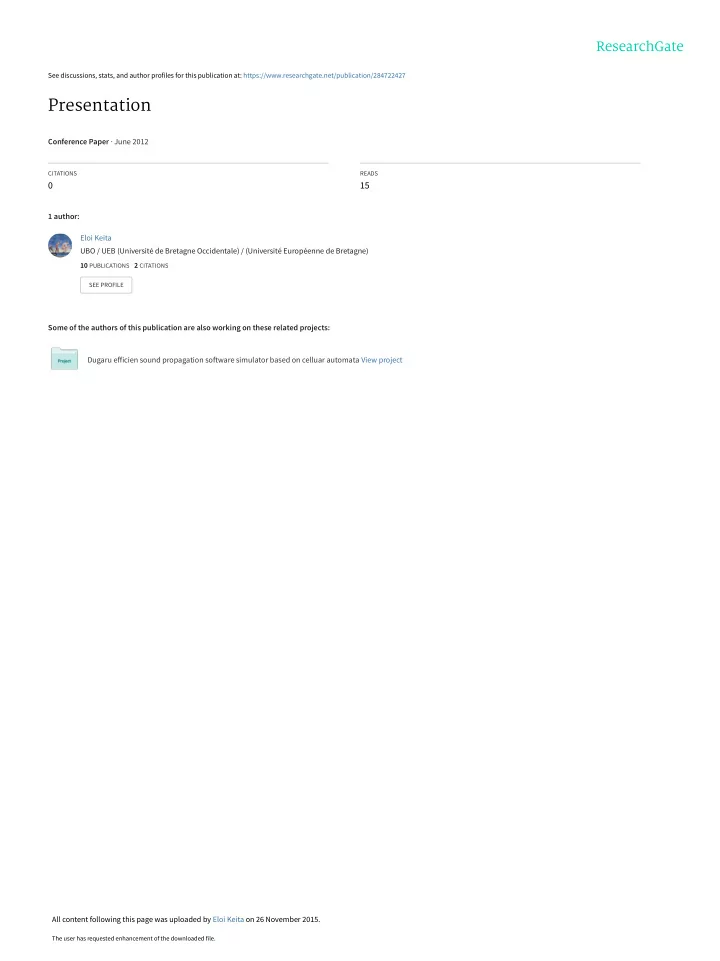

See discussions, stats, and author profiles for this publication at: https://www.researchgate.net/publication/284722427 Presentation Conference Paper · June 2012 CITATIONS READS 0 15 1 author: Eloi Keita UBO / UEB (Université de Bretagne Occidentale) / (Université Européenne de Bretagne) 10 PUBLICATIONS 2 CITATIONS SEE PROFILE Some of the authors of this publication are also working on these related projects: Dugaru efficien sound propagation software simulator based on celluar automata View project All content following this page was uploaded by Eloi Keita on 26 November 2015. The user has requested enhancement of the downloaded file.
A Test Case for a Wireless Sensor Network Design Flow Eloi KEITA , Pierre-Yves Lucas, Ahcène Bounceur, Bernard Pottier LabSTICC Laboratory , UMR 3192 University of Brest (UBO), France European University of Brittany (UEB) Lorient, June 7 th , 2012
Outline Outline ● Introduction ● The standard 802.15.4 (ZigBee) ● Arduino system ● XBee USB platform ● Voyage Linux & Meshlium box ● Presentation of the application ● Results ● Conclusion 2
Introduction ● In this presentation, we will discuss about one example of pervasive application. ● Presentation of some experiments conducted on a commercial hardware multi-interface, supporting Linux, which allows to control the sensor networks. ● Integrating the data collected in a classical information systems. ● This work will be integrated in a project of methodological flow allowing to ensure a high performance sensor networks simulation, and the synthesis of local code of sensors (NetGen). 3
Software and tools in the Labsticc: NetGen, a design flow « top down » ● Topologies, simulation and execution ● Mobiles and sensors ● Simulation on GPU Simulation ➔ MIMD multi-threaded Occam, slow compilation ➔ CUDA SIMD, fast compilation ➔ Interactive tools generation and control of the GPU ➔ Draft of implementation - TDMA nodes TI ➔ Mobility: ➔ Study of generators for Occam-Pi. 4
The standard 802.15.4 (ZigBee) Comparison of Zigbee compared to other wireless protocols IEEE 802.15.4 is a standard which specifies the physical layer and media access control for low-rate wireless personal area networks (LR-WPANs) ZigBee is a specification for a suite of high level communication protocols using small, low-power digital radios based on an IEEE 802 standard for personal area networks. 5
Arduino System Microcontroller: Arduino ATMega2560 A.RISC One of the most accessible commercial solutions is from the field of software and of the free architecture. It is based on a low-consumption Atmel processor family known under the name Arduino, Humidity Temperature OR Sensor Sensor 6
Wireless Sensor Networks In Practice: Two XBee modems communicate : We connected a modem, the Xbee module on Arduino. The objective is to connect all on a card which will be connected to the analog inputs. This allows to obtain the temperature and humidity. A first modem receives the transmitted data. A second modem connected to the USB platform receives the packets of the first modem 7
Voyage Linux ● Voyage Linux is Debian derived distribution that is best run on a x86 embedded platforms such as PC Engines ALIX/WRAP, Soekris 45xx/48xx/65xx and Atom-based boards, Meshlium, … ● It can also run on low-end x86 PC platforms, ● Voyage Linux is so small that it is best suitable for running a full-feature firewall, wireless access point, Asterisk/VoIP gateway, music player or network storage device . 8
The application was made : an example of wsn Sensors : Arduino, Meshlium and XBee Meshlium : Operating Model → Embedded Linux (version Voyage) → DB : MySQL → Gateway GPS → Xbee – 802.15.4, wifi and Bluetooth The characteristics of the Meshlium used as part of this work are given as follows: • Processor: 500MHz (x86) • RAM memory: 256MB (DDR) • Disk memory: 8GB / 16GB / 32GB • Power: 5W (18V) • Power Source: POE (Power Over Ethernet) 9
Application System Multi-Interface Wireless Sensor Network Retrieve the temperature and the humidity in a laboratory every 10 minutes for a period of 24 hours, and store them in a database which is available on line. 10
Results obtained Temperature curve plotted from data stored in MySQL Temperature$ 15,4$ 15,3$ 15,2$ 15,1$ Celsius)$ 15$ (Degree$ 14,9$ 14,8$ °C$ 14,7$ 14,6$ 14,5$ 14,4$ 0:00:00$ 2:24:00$ 4:48:00$ 7:12:00$ 9:36:00$ 12:00:00$ 14:24:00$ 16:48:00$ 19:12:00$ 21:36:00$ 0:00:00$ Time$ 11
Results obtained Moisture curve plotted from data stored in MySQL Humidity# 60# 55# 50# 45# 40# %# 35# 30# 25# 20# 15# 10# 0:00# 1:12# 2:24# 3:36# 4:48# 6:00# 7:12# 8:24# 9:36# 10:48# 12:00# Time# 12
Conclusion and outlook A- In this work, we presented a Wireless application that store in a database values of differents sensors connected to a Meshlium system. B- These values can be accessed by internet via Wifi or GPRS network. C- This application requires the use of several domains that are mainly: 1- Embedded Linux (Voyage Linux) . 2- Programming languages (C, java et php), MySql.) 3- Sensors programming ( XBee, Libelium, Arduino, Meshlium...,) 13
Questions / Answers THANK YOU ... 14 View publication stats View publication stats
Recommend
More recommend